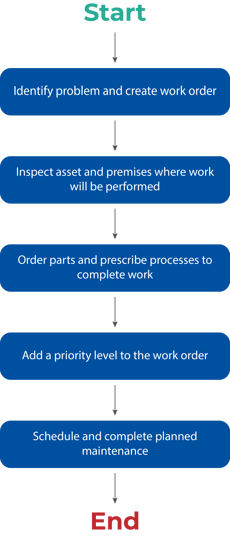Corrective Maintenance
Preventing unscheduled downtime before it happens
What is corrective maintenance?
Corrective maintenance, also known as breakdown maintenance or run-to-failure maintenance, describes restorative maintenance tasks done to rectify faulty systems or equipment. These tasks are usually assigned after an unforeseen defect is discovered during routine preventive maintenance. Corrective maintenance is done to fix problems before they escalate into equipment failure or large-scale breakdowns that can bring production to a grinding halt.
Examples of corrective maintenance
Emergency Repairs — Urgent repairs that must be done immediately to prevent a breakdown. For example, fixing a subway door that won’t close, which forces service to stop.
Service outages — Restoring services that are down, such as fixing a broken telephone line.
Repairs — Repairing things that are broken, such as a burst water pipe.
Performance — Restoring something to optimal performance, such as software that is performing slowly.
Quality Assurance — Correcting poor quality, such as an AC unit that makes a lot of noise.

Here's why it's important.
Corrective maintenance can keep a small problem from escalating. For example, while repairing the fan belt in an AC unit, a technician discovers the refrigerant is leaking. Fixing the leak would be considered corrective maintenance because the task was scheduled after the problem was found (which is a reactive approach to maintenance).
Perhaps the leak wasn’t bad enough to prevent the AC from functioning. However, without a corrective maintenance intervention, the refrigerant leak could worsen to the point where it becomes a health hazard. Failure to conduct corrective maintenance upon problem discovery often results in emergency maintenance down the road, which can interrupt service.
Dispelling a common myth about corrective maintenance
Understandably, there’s a common misconception that corrective maintenance is used as a last resort and represents a lack of a maintenance plan, but that’s not always the case.
When included as a conscious part of a maintenance plan, corrective maintenance actually represents a controlled, cost-effective way of maintaining ancillary equipment. Preventive maintenance, by contrast, is typically reserved for high-value assets that are expensive to replace or significantly impede production in the event of a breakdown.
When is the right time to use corrective maintenance?
While preventive maintenance is an excellent way to extend asset life cycle and curtail unscheduled downtime, corrective maintenance may be a better solution in some cases.
When non-critical assets are inexpensive and easy to repair or replace.
When a system has redundancies that allow it to operate properly even if a part fails.
When asset failure doesn't affect equipment safety.
How to integrate corrective maintenance into your maintenance plan
Corrective maintenance should be a conscious decision on the organization's part, with a polished workflow that functions as part of the overall maintenance strategy.
Create a system for reporting problems
Machine operators and other employees need a quick and easy way to report problems, such as through a request box or a work request form on your website or employee portal that is integrated with your CMMS.
Either way, a paper or digital trail is crucial so that tasks don’t fall by the wayside. A member of the maintenance team should be appointed to check these requests regularly and assign tasks.
Provide your technicians with detailed work orders
Technicians need access to necessary information needed for corrective tasks, including problem description and asset history.
Schedule corrective maintenance tasks
Maintenance planners need an efficient way to schedule and monitor maintenance so that they can easily incorporate corrective maintenance tasks as they arise, and triage tasks accordingly.

Here's where a CMMS becomes vital.
The corrective maintenance process
1. Detect the failure (this usually happens during a preventive maintenance task)
2. Diagnose the problem — What parts are faulty? If it’s a fast fix, the problem is rectified immediately. If not, the technician creates a work order.
3. Eliminate the defective part
4. Order a replacement part — If you have a reliable corrective maintenance strategy, you’ll already have this part in stock
5. Implement and test function
6. You're all set!

Advantages
- Lower short-term costs — Corrective maintenance only occurs as needed, meaning no extra maintenance costs until a problem arises. Preventive maintenance takes place periodically even if a piece of equipment is functioning normally.
- Minimal planning required
- Better solution for non-critical equipment — Sometimes, the shutdown and repair costs in case of equipment breakdown are less than the cost of preventive maintenance.
- Corrective maintenance planning improves over time — Data can be analyzed to identify trends in asset life cycle and plan for preventive maintenance.
Disadvantages
- Unpredictability — Since equipment is not monitored after purchase, failure is highly unpredictable. This can result in unavailable materials and increase the amount of time required for a repair.
- Potentially reduces the useful life of assets — Lack of periodic preventive maintenance can cause parts to wear out faster.
- Higher long-term costs — When major equipment failure happens, downtime can be extremely costly, eroding the organization's reputation, customer satisfaction and security.
Types of corrective maintenance
1. Planned corrective maintenance
A run-to-failure strategy represents a conscious decision to let a piece of noncritical equipment run until it breaks down because it has been deemed redundant or inexpensive to fix. Planned corrective maintenance can even be used as a part of a preventive maintenance or condition-based maintenance strategy, which consists of attempting to find problems before they cause equipment failure.
2. Unplanned corrective maintenance
Unscheduled corrective maintenance occurs when a preventive maintenance schedule is in place but a breakdown occurs between scheduled maintenance, or when an asset unexpectedly shows signs of potential failure.
How a CMMS can help with corrective maintenance
 1. Streamline the reporting process
1. Streamline the reporting process
A CMMS provides a fast and easy way for machine operators and other employees to report problems. Create an online form where people can submit a ticket, which will be managed and overseen by the maintenance team.
This prevents technicians from receiving work request phone calls while they’re in the middle of other important work, with no paper or digital trail to keep track of scheduling.
Customize the form by allowing users to submit photos and indicate task priority as well as identifying information such as building number (in a large facility) and equipment type. Doing so standardizes work order requests, prevents ambiguities and enables maintenance planners to triage corrective tasks more effectively.
 2. Optimize the workflow
2. Optimize the workflow
Create a set of standard maintenance procedures technicians can follow when dealing with complex assets. Even if these assets aren’t currently under a preventive maintenance plan, you can still minimize downtime and maintenance costs by preparing for the asset’s eventual degradation.
CMMS features help facilitate this process by providing quick access to maintenance logs for every asset, a spare parts management system that helps control inventory so you never run out of replacement parts and centralized information about each asset (OEM recommendations, fault patterns and maintenance procedures).
 3. Manage scheduling
3. Manage scheduling
Scheduling corrective maintenance alongside other preventive maintenance tasks is essential to ensure that problems don’t go unaddressed. For each corrective maintenance task, assign a level of urgency, from high to low.
When a work request comes in, the maintenance planner needs a real-time view of what each technician is working on and which ones can be safely pulled into other tasks. It’s always best to use a technician who isn’t in the middle of another task instead of interrupting a task that is in progress.
A CMMS gives you insight into the following information:
- List of active corrective tasks
- List of tasks that still need to be scheduled
- Which technicians are assigned to cover which tasks
- Who is available to cover corrective tasks that still need to be scheduled
 4. Create communication channels
4. Create communication channels
Remember that corrective maintenance doesn’t only concern the maintenance team. Employees who work with assets that are waiting to be repaired need to be updated on the progress of maintenance work.
For example, say the maintenance manager didn’t notify the line manager that a technician is coming. The technician would have to wait around until production stops or the space is clean and ready for him to start.
A mobile CMMS comes with a built-in chat function that makes it easy for managers to communicate with each other onsite, as well as push notifications that notify managers of important changes.
Conclusion
Although corrective maintenance can be the proper maintenance strategy for certain types of assets and situations, it is not the best approach for all assets and situations. It can often lead to costly downtime, shortened life of assets, unsafe working conditions, and more.
An effective maintenance strategy should also include preventive and even predictive maintenance, and there is no better way of implementing preventive and predictive maintenance than with a CMMS.

 For immediate assistance, please call us at (512) 328-3235
For immediate assistance, please call us at (512) 328-3235